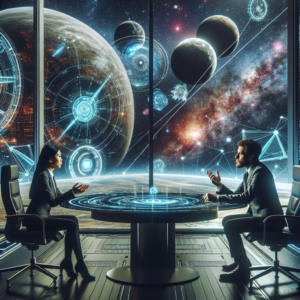The Man Out to Prove How Dumb AI Still Is
Artificial Intelligence (AI) has rapidly evolved over the past few years, promising to revolutionize industries and improve everyday tasks. Yet, despite the significant advancements, there remains a lingering question: how intelligent is AI really? A recent article from The Atlantic delves into the quest of an individual aiming to showcase just how far we have yet to go in understanding and harnessing AI’s true potential. This blog post will explore the insights from the article, highlighting the key points and implications of the ongoing conversation about AI’s capabilities and limitations.
Introduction to the AI Debate
AI has become a buzzword, often associated with cutting-edge technology and futuristic innovations. Companies are investing billions into developing AI systems that can perform tasks ranging from natural language processing to image recognition. However, a closer examination reveals that these systems often operate under a façade of intelligence that can be easily unraveled.
The drive to showcase AI’s shortcomings stems from a desire to foster a more critical dialogue about its capabilities. The individual at the center of this discussion is not merely content with accepting AI’s current state; instead, he is committed to revealing its inadequacies in a way that encourages greater scrutiny of its application.
Understanding AI’s Limitations
AI systems, particularly those that utilize machine learning, have shown remarkable efficacy in certain areas. However, they are also prone to errors and misunderstandings, often echoing the limitations of their underlying data. Here are some critical limitations of AI highlighted in the article:
1. Contextual Understanding: AI lacks true comprehension of context. While it can analyze data patterns and produce responses, it often fails to grasp the nuances of human communication, leading to misinterpretations.
2. Common Sense Reasoning: Unlike humans, AI systems do not possess common sense reasoning. They can struggle with tasks that require an understanding of everyday concepts, which can result in ludicrous outcomes when faced with unexpected scenarios.
3. Bias in Data: AI systems learn from historical data, which can be biased. As a result, AI can perpetuate and even amplify existing prejudices inherent in the data it processes, leading to ethically questionable outcomes.
4. Dependence on Quality of Data: The effectiveness of an AI system is heavily dependent on the quality and comprehensiveness of the data it uses. Incomplete or poorly curated datasets can yield unreliable AI outputs.
5. Lack of Creativity: Despite being programmed to imitate creativity, AI lacks the intrinsic understanding and emotional depth that fuel human creativity. This can limit its ability to innovate in ways that are truly impactful.
The Man Behind the Mission
The article features a dedicated individual who has taken it upon himself to expose these limitations. He employs various methods to demonstrate AI’s shortcomings, including conducting experiments that reveal how AI can be easily misled or confused. By doing so, he aims to educate people about the technology they often take for granted.
This individual’s mission is not merely about highlighting flaws; it is about fostering a deeper understanding of AI. His approach encourages organizations and developers to rethink how they utilize AI, pushing for a more responsible and informed application.
Experiments and Demonstrations
One of the most compelling aspects of the article is the description of the experiments conducted by this individual. These demonstrations serve as stark reminders of AI’s limitations, providing real-world examples that resonate with audiences. Some of the experiments include:
– Conversational AI Tests: By engaging with conversational AI systems, the individual showcases how these technologies can falter when faced with ambiguous or complex queries. The interactions often reveal a lack of genuine understanding, prompting laughter while simultaneously raising concern.
– Image Recognition Challenges: In this experiment, the individual presents AI with images that are intentionally misleading. The AI’s erroneous interpretations illustrate its reliance on patterns rather than a true grasp of visual content.
– Scenario-Based Role Plays: By presenting AI with hypothetical scenarios, he demonstrates how the lack of reasoning and emotional intelligence can lead to inappropriate or nonsensical outputs.
Through these experiments, the individual not only entertains but also enlightens audiences about the intricacies of AI. His work challenges the prevalent narrative that AI is infallible and encourages a more nuanced perspective.
The Implications of AI’s Limitations
Understanding the limitations of AI is crucial as society continues to integrate this technology into various facets of life. The implications of these limitations are far-reaching, affecting areas such as:
1. Policy Development: Policymakers need to be aware of AI’s shortcomings when crafting regulations. Informed decisions can help mitigate risks associated with biased algorithms and ensure ethical AI usage.
2. Public Perception: As the public becomes more aware of AI’s limitations, it can lead to a healthier skepticism regarding the technology. This skepticism can result in more responsible development practices.
3. Technological Innovation: Recognizing AI’s flaws can drive innovation, compelling researchers and developers to create better, more robust systems that address existing challenges.
4. Job Market Dynamics: As organizations adopt AI, understanding its limitations can influence workforce planning. While AI can enhance productivity, it cannot replace human intuition and creativity.
5. Ethical Considerations: Conversations around AI’s limitations can spur discussions on ethics, prompting developers to consider the societal impacts of their innovations.
Conclusion: The Future of AI and Human Interaction
The journey to demystify AI and its limitations is ongoing. The individual featured in The Atlantic article serves as a catalyst for this essential conversation, reminding us that while AI holds incredible potential, it is not without its flaws. As society continues to embrace AI, it is vital to maintain a critical eye on its capabilities, ensuring that ethical considerations guide its development and application.
In essence, the dialogue surrounding AI should not be confined to its successes but should also encompass its shortcomings. Through understanding and addressing these limitations, we can work towards a future where AI complements human intelligence rather than attempting to supplant it. This collaborative approach can lead to innovations that benefit society while fostering a respectful relationship between humans and technology.



